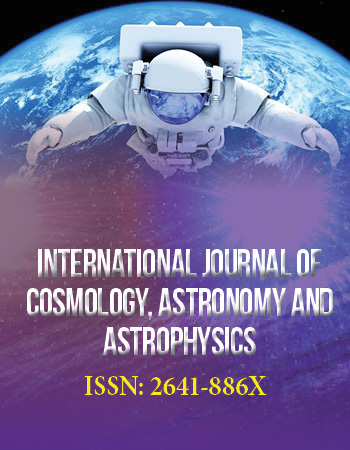Research Article
Total Solar Eclipses in Europe during the Megalithic Period
Department of Physics and Astronomy, Uppsala University, Sweden
*Corresponding author: Göran Henriksson, Department of Biological Sciences, Faculty Department of Physics and Astronomy, Uppsala University, Sweden, E-mail: goran.henriksson@physics.uu.se
Received: August 24, 2023 Accepted: September 26, 2023 Published: October 06, 2023
Citation: Henriksson G. Total Solar Eclipses in Europe during the Megalithic Period. Int J Cosmol Astron Astrophys. 2023; 5(2): 221-230. doi: 10.18689/ijcaa-1000142
Copyright: © 2023 The Author(s). This work is licensed under a Creative Commons Attribution 4.0 International License, which permits unrestricted use, distribution, and reproduction in any medium, provided the original work is properly cited.
Abstract
With my new well-calibrated computer program Sunmoon, for calculation of ancient solar eclipses it has been possible to identify Megalithic depictions of seven total solar eclipses in Ireland, France, Spain and Sweden, made between 3574 and 3146 BC. An earlier investigation showed that the computer program works very well for this distant epoch by the identification of four total solar eclipses 3653 – 2470 BC, on Sumerian cylinder seals, and a total solar eclipse in 3245 BC depicted on a kerbstone at the passage grave Knowth, in Ireland, dated to about 3200 BC. Different methods to calculate ancient solar eclipses will be discussed.
Keywords: Total solar eclipse, Megalithic period, rock-carving, lunar secular acceleration, mass of the graviton
Introduction
My first calculations of total solar eclipses during the Megalithic period were published in Swedish already in 1989, for example Henriksson (1989). However, at that time it was not obvious that my computer program, mainly based on the theory by Carl Schoch (1931), was good enough to give more than preliminary results, but it was clear that the zone of totality of the solar eclipse in 3337 BC followed the Atlantic coast from the west coast of Portugal via the Carnac area in France, the coast of the Netherlands, across southern Denmark and southern Sweden. This zone covered some important parts of the distribution area of Megalithic passage graves, but in 3328 BC, after just 9 years, there was another total solar eclipse that covered the remaining parts of the main distribution area of the passage graves in Western Europe.
The total zone of the solar eclipse in 3299 BC covered a narrow area including central Denmark, southern Sweden and the Swedish islands Öland and Gotland in the Baltic Sea. After that almost all Swedish passage graves, except those in the province of Bohuslän, had been within total zones of solar eclipses between 3337-3299 BC. Depictions of these total solar eclipses have been found as rock-carvings and one depiction on a well-preserved funnel beaker vessel in a passage grave in the province of Scania.
The solar eclipse in 3245 BC had a total zone in Ireland that included the Boyne Valley and the gigantic passage graves Newgrange and Knowth that have been dated to about 3200 BC.
After a visit, in 1995, to these magnificent passage graves, with its great number of depictions both inside the chambers and on the surrounding kerbstones, it was clear to me that some of the motives were depictions of total solar eclipses. At the first sight I was convinced that on kerbstones NE 6, at Knowth, there was a depiction of a total solar eclipse with Venus visible to the lower left of the totally eclipsed solar disk just above the eastern horizon.
Therefore, I calculated all the solar eclipses back to 4000 BC visible at Knowth. The only total solar eclipse that matched perfectly with these criteria took place as early as 3574 BC, long before the building of the passage grave at Knowth. However, another total solar eclipse that took place in 3245 BC corresponded very well to the archaeological dating of this passage grave. It had also Venus to the left of the eclipsed sun, but at Knowth Venus was unfortunately situated about one degree below the horizon and had not been visible. At first, I thought that it may have been within the margin of error in my preliminary calculations, but it was later found that there are no such great errors in my calculations.
The total solar eclipse in 3146 BC took place close to the sunset in Ireland and must have made a deep impression on the inhabitants. There is one picture within the total zone with the eclipsed sun just above and another one with the sun on the horizon. This means that the error in the calculated time is less than one minute. Two depictions were made just to the south of the southern limit of the total zone.
All dates are given in the Gregorian calendar.
A New Calibration of the Sidereal Lunar Secular Acceleration in Longitude
In the spring of 2004 I had finished my analysis of the influence of non-gravitational effects on the braking of the earth’s rotation. I found that over long time intervals, such as thousands of years, there was no significant net effect at all. Because it seemed to me as if I had the best possible formula for calculation of the longitude of the moon, I decided to use the Third Law by Kepler to test this formula together with the improved measurements of the distance to the moon by laser technique, using the reflectors put on the surface of the moon during the Apollo project, Chapront et al (2002). It was found that there was significant excess in the secular acceleration in the lunar longitude that matched with the “precession of the geodesic” according to the Theory of General Relativity by Einstein (1916). This conclusion was presented at the SEAC2008 Conference in Granada, Henriksson (2009, 2010).
However, I realized that my calculation of the lunar longitude was not optimal because Carl Schoch (1931) had introduced a third order fitting parameter. In his formulas he used UT and the apparent acceleration of the sun and the moon and there is no need to determine Delta T = ET - UT used in other methods. In 2011, I decided to eliminate this third order term and to determine a new second order physical term that represented the true secular acceleration of the moon’s longitude. The new second order term was determined from calculations of 33 total or almost total solar eclipses back to 3653 BC (Henriksson 2017), Figure 1.
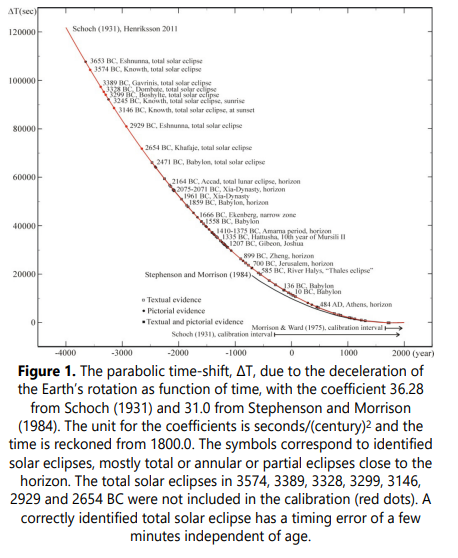
The new value for the sidereal lunar secular acceleration, -30.128 ±0.0035 “/cy2, gives an even better agreement with the ancient observations than with Schoch’s original formula.
The weighted mean of the lunar secular acceleration from the Lunar Laser Range (LLR)-measurements in the Earth-Moon inertial system is: -25.856 ±0.003 “/cy2 Chapront et al (2002) and Williams et al (2008).
The published value for the precession of the geodesic was only given by two decimal precision. To preserve the precision in the observations I had to make a new calculation with four decimal precision, according to the theory by Nordtvedt (1995). The new improved value for the precession of the geodesic is -1.8018 “/cy2, and the total relativistic effect -3.6036 “/cy2. After correction of the LLR- measurements for this relativistic effect we get the lunar secular acceleration, -29.6938 ±0.003 “/cy2. If this value is subtracted from the observed sidereal lunar secular acceleration, -30.128 ±0.0035 “/cy2, calibrated by Henriksson in 2011, we get -0.6685 “/cy2, with the total uncertainty ±0.0046 “/cy2.
A theory for modified gravity predicts an additional cosmological precession of the Earth-Moon-system (Dvali et al. 2003). From their formulas, in chapter 3, I have calculated this effect as -0.5227 “/cy2, with the radius of crossover rc = 6 Gpc. If the observed additional acceleration, -0.6685 ±0.0046”/cy2, is interpreted as the cosmological precession, the corresponding radius of crossover is 4.69 Gpc or 15.3 billion light years. According to chapter 4 in Dvali et al. (2003), the mass of the graviton mg = 1/rc. After converting units it is found that the Mass of the Graviton is 1.31 ±0.01 x 10-56 grams.
The new optimized value for the sidereal lunar secular acceleration has been used in all calculations after 2011 and the new formula for the lunar longitude is useful some thousands of years before the so far oldest identified total solar eclipse in 3653 BC.
The idea used below has been to try to identify characteristic details in the ancient depictions with unique phenomena visible in the sky only during the total phase of solar eclipses, as calculated with my computer program. Such phenomena may be planets or comets visible close the sun or visible constellations.
Three Identified Total Solar Eclipses in Ireland
At the SEAC1998 Conference in Dublin there was an excursion to the magnificent passage graves at Newgrange and Knowth. I got now a possibility to ask Professor George Eogan, the main investigator of Knowth, if the kerbstone NE 6, with the totally eclipsed sun and Venus, could have existed as a separate standing stone long before it was included as a kerbstone of the passage grave. He answered that nothing contradicted this hypothesis. Nothing prevented now my identification of this depiction as the total solar eclipse in 3574 BC, Figure 2a-b.
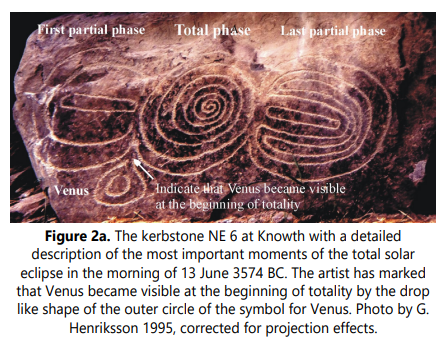
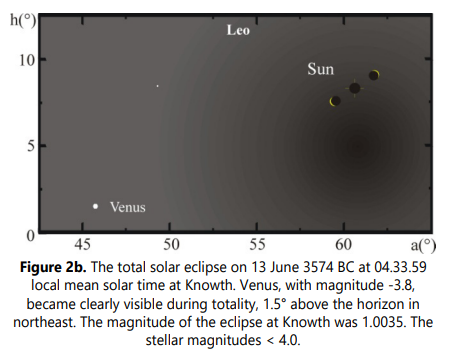
There exist many depictions of Comet Encke on the Swedish rock-carvings. This made it possible to calculate its orbit and it was included in my computer program for the sun, moon, planets and stars (Henriksson 2018, 2020).
In 2016, I calculated the sky close to the eclipsed sun during the total solar eclipse in 3245 BC. During the totality Comet Encke could be seen at its perihelion, when the comet was brightest, Figure 3a.
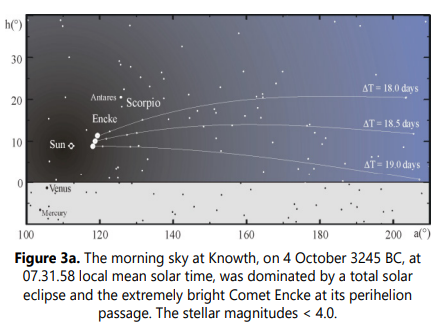
After a close examination of the other kerbstones at Knowth it became clear that on kerbstone SE31, there existed a depiction of this unique moment with Encke visible to the right of the sun during the total phase of the solar eclipse in 3245 BC. From this very realistic depiction, Figure 3b, it was possible to determine the actual time-shift of Comet Encke as 18.5 days from my standard orbit. The comet’s long tail had been seen during the last weeks, but during the total phase of the eclipse it was even possible to see its bright nucleus at its maximum brightness close to the sun.
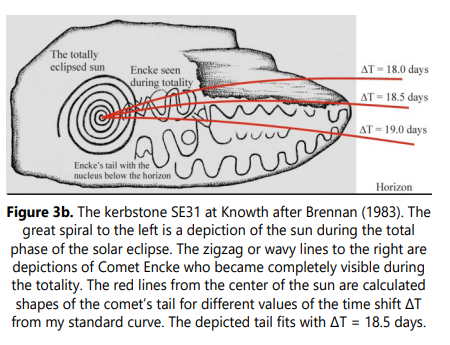
The most remarkable total solar eclipse in Ireland took place close to the sunset in 3146 BC. It must have made a deep impression on the contemporary inhabitants of Ireland because it was depicted at four different sites, Figures 4 and 5a-b.
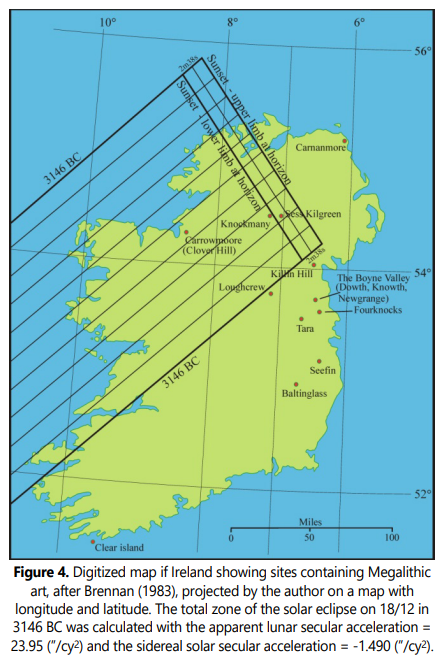
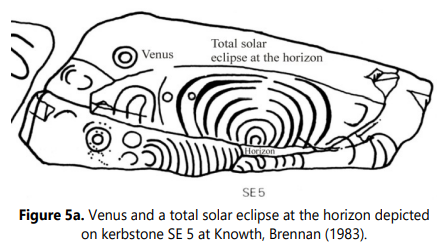
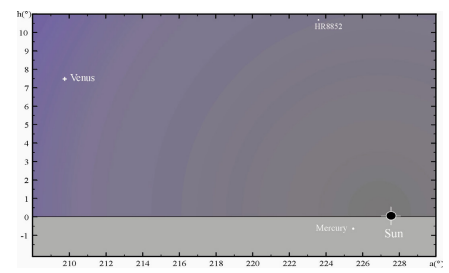
Figure 5b. During sunset at Knowth, on 18/12 in 3146 BC, at the winter solstice, there was an almost total solar eclipse. At 15.47.17, local mean solar time, the last visible crescent-like lower part of the sun disappeared below the horizon. At that moment the totally eclipsed upper half of the sun was still above the horizon and it became so dark that Venus was visible, but Mercury was already below the horizon.
This solar eclipse was identified in 2011 and was used as an independent test of my new formula for the sidereal lunar secular acceleration in longitude. It was also a rare opportunity to test the sidereal solar secular acceleration in longitude, which corresponds to the deceleration of the earth’s rotation, ΔT, in the formulas by Schoch (1931), Figure 5c.
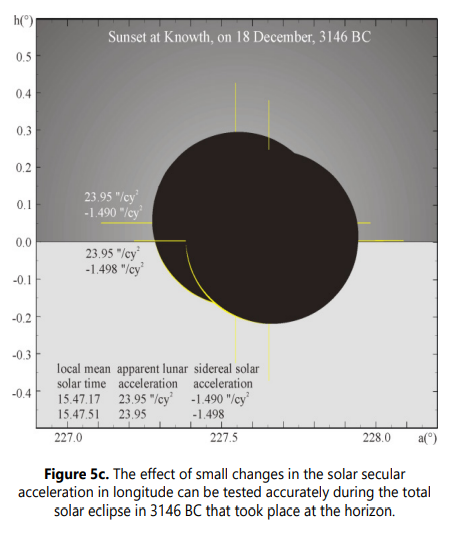
The unique situation with a total solar eclipse taking place at the horizon on Ireland, with its depictions of celestial motifs, many of them solar symbols, was promising.
The first identified depiction of the total solar eclipse at the winter solstice in 3146 BC was found on the kerbstone SE 5 at Knowth, Figure 5a-b. Knowth was situated to the south of the total zone, but it became equally dark as during a total solar eclipse when the thin non-eclipsed crescent at the lower limb of the sun disappeared below the horizon, Figure 5c.
Another site, Loughcrew, was situated just outside the southern zone of totality, Figure 6a-b. The maximum magnitude of this solar eclipse was 0.9984 at Loughcrew, with the standard values of the lunar apparent and the solar sidereal secular accelerations. One minute after the maximum phase, at 15.45.16, the uneclipsed lower limb of the sun disappeared completely below the horizon, Figure 6a.
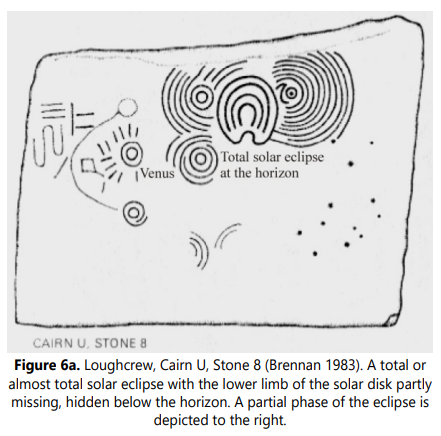
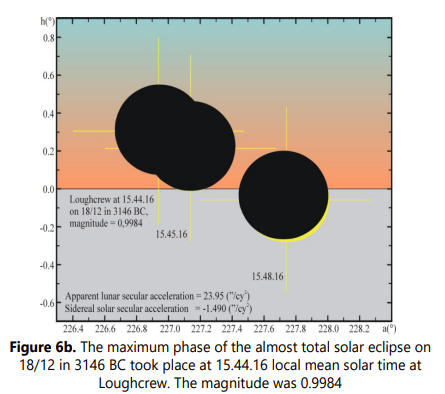
Another site, Loughcrew, was situated just outside the southern zone of totality, Figure 6a-b. The maximum magnitude of this solar eclipse was 0.9984 at Loughcrew, with the standard values of the lunar apparent and the solar sidereal secular accelerations. One minute after the maximum phase, at 15.45.16, the uneclipsed lower limb of the sun disappeared completely below the horizon, Figure 6a.
Two depictions of the total solar eclipse in 3146 BC were made in Northern Ireland, both within the total zone. At Knockmany the totally eclipsed sun was correctly depicted clearly above the horizon, but it was also depicted as if it was above the horizon at Sess Kilgreen, where less than the upper half of the totally eclipsed sun would have been visible with zero horizon altitude. The observation may have been made from a nearby hilltop or there exist an error in my calculated time with about 40 seconds, Figure 4.
This was an extraordinary eclipse at Sess Kilgreen because the maximum phase took place when the centre of the solar disk was a few arcminutes below the zero horizon. Mercury was setting, 15.42.15, about five minutes before the beginning of totality, and could not have been visible during the eclipse. It is therefore remarkable that Mercury is correctly depicted below the horizon on the standing Stone 6. People must have understood that Mercury was close to the sun during this eclipse from extrapolations of observations made some days earlier, Figure 7a-b.
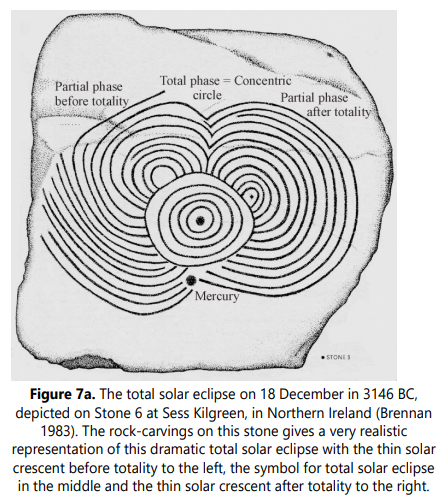
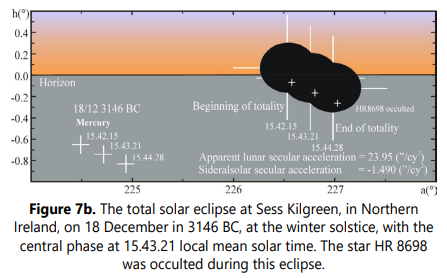
Two Total Solar Eclipses at Carnac in France
The most famous monument at Carnac, in northwestern France, “Le Grand Menhire Brisé”, was originally 21 m high and its weight was 320 tons. It is today broken into four pieces. Next to this giant there had been another menhir, 14 m high that had been broken into three pieces. The middle one was used as the roof stone in the huge passage grave at Gavrinis. On that stone there is a rock carving that can be identified as the total solar eclipse on 8 July in 3389 BC in Leo, and visible below the Big Dipper, that is depicted above the eclipsed sun, Figure 8a-c.
On the wall opposite to the entrance, in a nearby passage grave at Mané Lud, there is a depiction of the total solar eclipse on 28 March in 3328 BC.
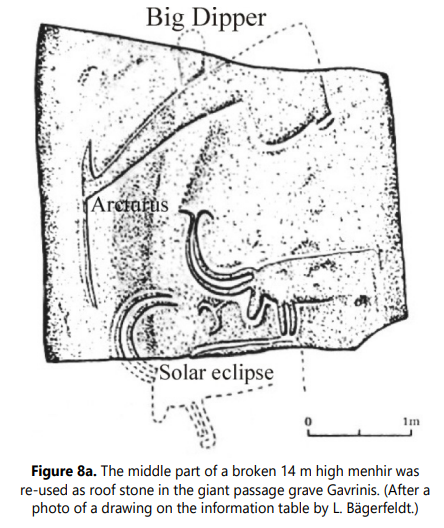
The upper figure corresponds mainly to the Big Dipper and its left part to a curved line through the bright star Arcturus in Bootes and that continues down to the lower left part where we can see two crescents. They correspond to partial phases some minutes before the totality and the small crescent to the right was seen immediately after the totality.
These crescents represented a total solar eclipse. The artist had in this unique way told the story about a total solar eclipse in Leo, visible below the Big Dipper.
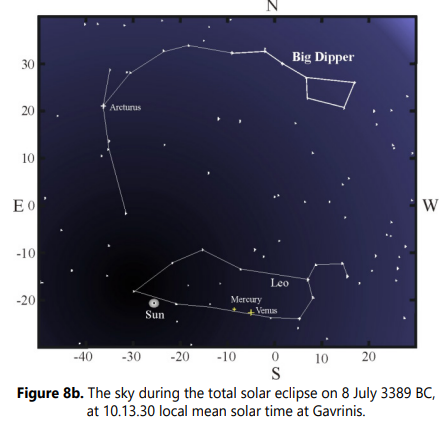
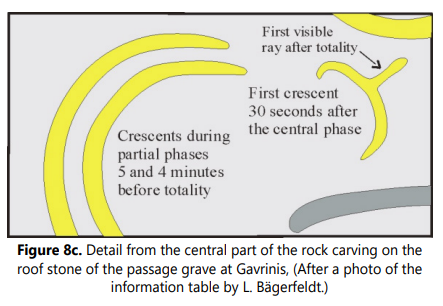
The Total Solar Eclipse at Dombate in Spain
During the SEAC2017 Conference in Santiago de Compostela there was an excursion to the Dombate dolmen in Galicia, in the northwestern corner of Spain. This gigantic dolmen was constructed about 3900 BC and it was used until 2700 BC. My attention was drawn to some rock-carvings on the wall opposite to the passage entrance, Figure 9a-b.
The main motifs were five beaker-like figures, but the four crescents convinced me that the motif was celestial. I suspected that the “beaker” corresponded to our constellation Gemini and that the thin crescent was not the trivial lunar crescent, but a depiction of a solar crescent visible after totality in “Beaker”.
The only total solar eclipse visible in Dombate 4000-2700 BC, took place on 28 March in 3328. The lower right thin crescent of the solar disk was visible some minutes after the totality, during which the planet Mercury had been visible close to the left of sun.
The three broad crescents correspond to a powerful partial solar eclipse in Dombate, in 3337 BC, only 9 years earlier, and almost at the same place in Beaker. The observers understood that the solar eclipse took place in Beaker even if no stars in this constellation were visible during the eclipse.
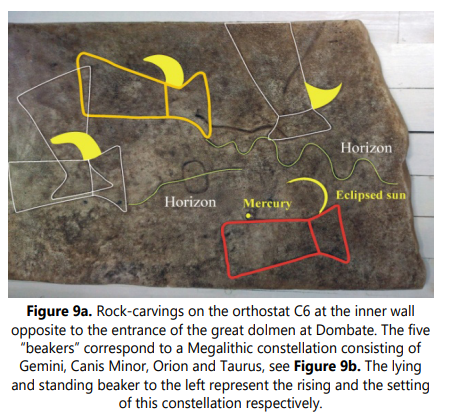
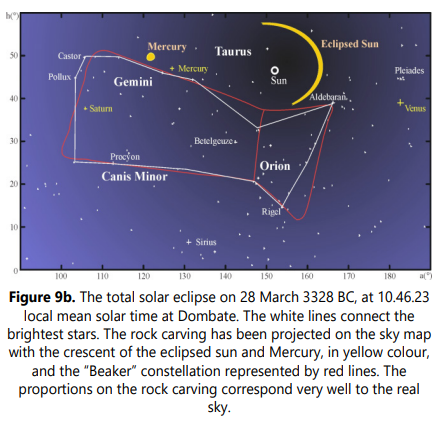
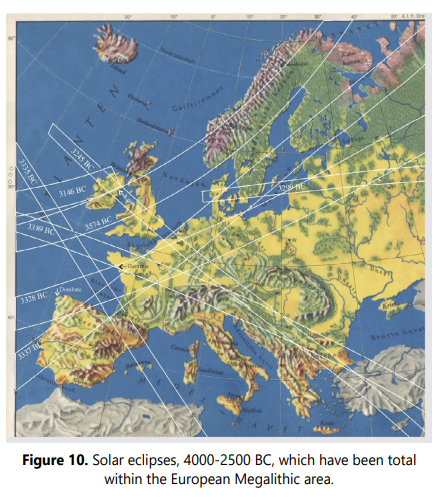
Two Total Solar Eclipses in Southern Sweden
In southern Scandinavia there was a remarkable total solar eclipse in 3299 BC, Figure 11. Close to the northern limit of the total zone, in the province of Halland, marked as 1 and 2, and on the island of Gotland in the Baltic Sea, marked as 3, there exist engraved semi-circular crescents on stones at neolithic sites. A few centimeters below the rim of a funnel beaker from a passage grave in the province of Scania, marked as 4, there exist unique depictions of solar discs with many thin radial lines that may illustrate the solar corona visible during the total solar eclipses in 3337 or 3299 BC.
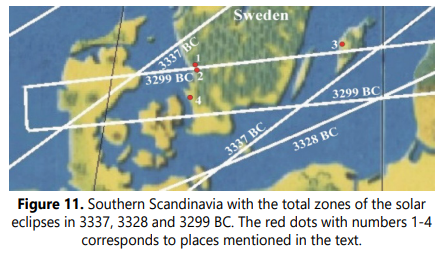
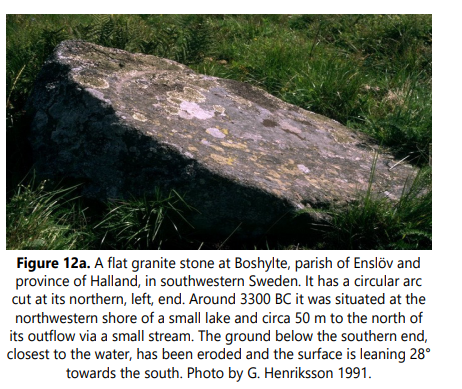
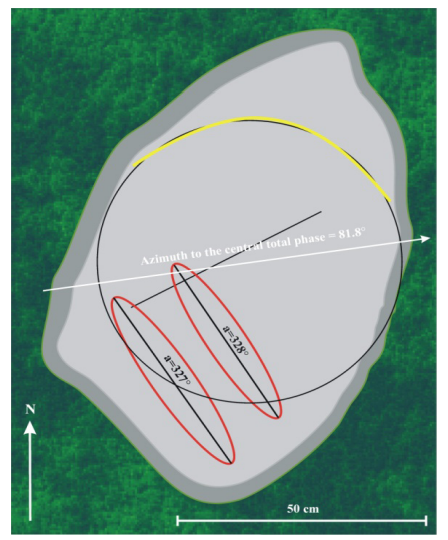
Figure 12b. A sketch of the granite stone at Boshylte with a circular arc at its northern half and two grinding grooves at its southern half, Figure 12a. The circular arc has been cut by a stone tool and is typically 2-3 cm wide and 1 cm deep. Its radius is about 31 cm, about one foot. The arc is a depiction of the last minute before the total phase of the solar eclipse, when only a narrow crescent of the solar disc was visible, Figure 12c. The grooves are about 40 cm long, 10 cm wide and 2 cm deep. There exist about 5000 such grooves in southern Sweden and the oldest have been dated to 3294 BC, Henriksson (2002). They represent a luni-solar calendar in which the azimuth to the rising or setting full moon has been marked by cutting a groove on a flat stone or the bedrock. Similar grooves can be found at the neolithic settlement at lake Sandsjön about 10 km to the north of Boshylte.
Fortunately, the azimuths of these grooves can be identified as the directions to the setting full moon at the winter solstice in 3283 and 3264 BC. (After a video frame from 26 July 2019, by G. Henriksson.)
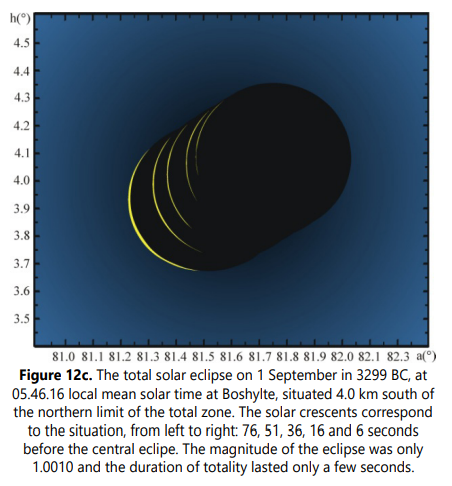
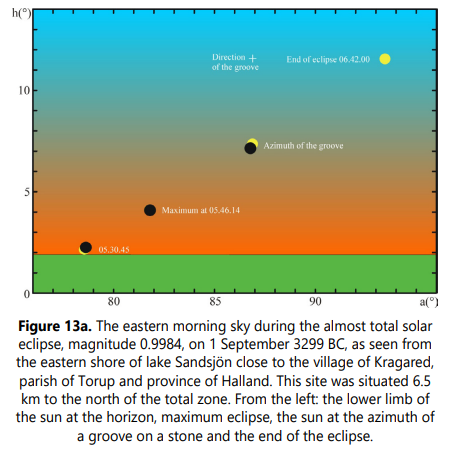
An almost 1 m long groove, Figure 13b, was cut on a big boulder pointing at the sky about 4° above the path of the rising sun, but with the same altitude as the sun at the end of the eclipse. On the vertical surface of a stone, 11 m to the south and 5 m to the east of this groove there exist a depiction, Figure 13c, corresponding to the partially eclipsed sun that the people could see in the morning sky in the same azimuth as the groove.
The same solar eclipse has been depicted at Byssegarde on the island of Gotland, in the Baltic Sea, Figure 14.
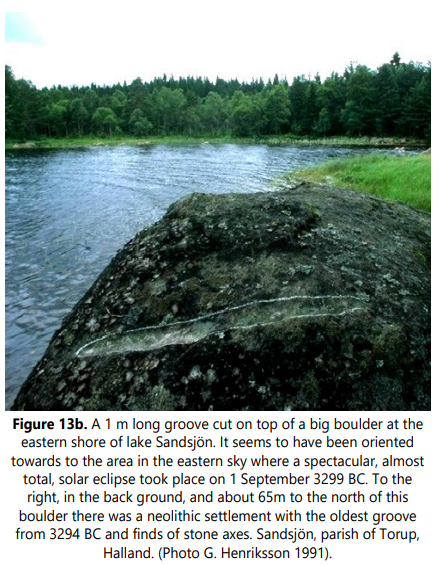
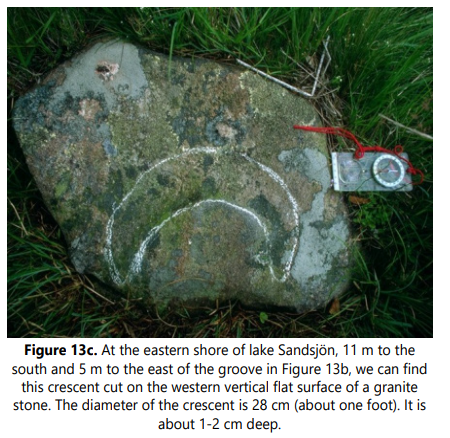
In the morning of 1 September in 3299 BC there appeared an almost total solar eclipse in the east with magnitude 0.9984. It was visible directly above this stone.
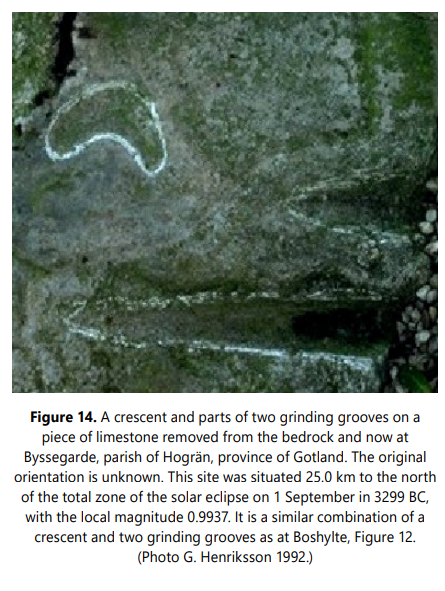
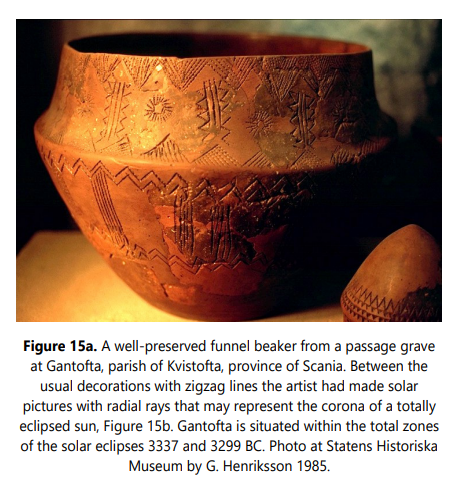
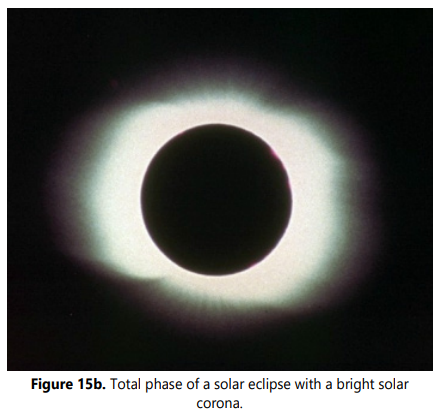
Summary
Total solar eclipses have always made a deep impression on human societies, and also on birds and animals. Everybody realize the great importance of the sun and it was natural to identify the sun as a mighty god. If its appearance in the sky was disturbed, as during solar eclipses, especially total eclipses, it has been considered as a catastrophe for the society and the responsible leaders have been punished. Different ceremonies have been developed to avoid the wrath of the sun god including human sacrifices. In order to understand what happened the leaders in some preliterate societies I have tried to document the solar eclipses by calculating what they had seen in the sky and then depicted as rock-carvings.
It is easy to depict a partial phase of a solar eclipse or an annular eclipse but very difficult to depict the total phase of a solar eclipse when the solar disc is completely covered by the moon and invisible.
Four different strategies have been used to document total solar eclipses in preliterate societies:
1) In Ireland, Boyne Valley, they invented a special symbol to represent the totally eclipsed sun - concentric circles. Cup marks represented planets and the brightest planet, Venus, was distinguished by a circle around the cup mark. To make the documentation unique they depicted the eclipsed sun together with visible planets in their correct relative positions and to the horizon, Figures 2-7.
2) In France, Carnac, they had invented constellations, by connecting the brightest stars in a certain area by lines, as for instance the Big Dipper. They used the constellations as a reference system to mark the position in the sky where the solar eclipse took place. The partial phases before and after the totality were depicted as the two opposite crescents they had seen in the sky, but without any symbol for the total phase. Figure 8.
3) In Spain, Dombate, they had also invented constellations by connecting bright stars with lines. To make the documentation unique they also depicted the constellation’s orientation in relation to the horizon. The position of the eclipsed sun, represented as a crescent, was placed correctly in the constellation together with visible planets, Figure 9.
4) In Sweden, at Boshylte and Sandsjön, they had no constellations in the sky as reference system. Instead they made depictions of the eclipsed sun as a crescent in the correct azimuth as at Boshylte, Figure 12, and at Sandsjön where even the altitude of the eclipsed sun had been documented by a 1 m long deep groove on top of a big boulder, Figure 13.
In the Swedish provinces Gotland, Scania and Halland they had invented a luni-solar calendar with the oldest documented year 3294 BC. It was defined by the years with full moon at the winter solstice and years when the full moon passed the bright stars Spica in Virgo and somewhat later Antares in Scorpio. This happened every nineteenth year and is today known as Meton’s cycle. The oldest grooves were oriented towards the rising or setting full moon on the day when it passed Spica, about 27 January, 5-6 days before the Midwinter day, defined as the day exactly between the winter solstice and the vernal equinox, about 2 February, Henriksson (2002). This was the coldest days of the year.
This calendar could have been used to document the year of the total solar eclipse in 3299 BC in relation to the full moon at the winter solstice in 3283 and 3264 BC as at Boshylte, Figure 12, and to the full moon in 3294 and 3283 BC as at Sandsjön, Figure 13.
The “sun” on the funnel beaker from Gantofta may represent a totally eclipsed sun surrounded by its corona, only visible during the totality in 3337 or 3299 BC, Figure 15. All solar eclipses with total zones passing the megalithic sites in Western Europe can be found in Figure 10.
References
- Chapront J, Chapront-Touzé M, Francou G. A new determination of lunar orbital parameters, precession constant and tidal acceleration from LLR measurements. Astron. Astrophys. 2002; 387: 700-709. doi: 10.1051/0004-6361:20020420
- Dvali G, Gruzinov A, Zaldarriaga M. The Accelerated Universe and the Moon. Phys Rev D. 2003; 68(2). doi: 10.1103/PhysRevD.68.024012
- Einstein A. Die Grundlage der allgemeinen Relativitätstheorie. Annalen der Physik. 1916; 49: 769-822.
- Henriksson G. A new test of Einstein’s theory of relativity by ancient solar eclipses. Cosmology across Cultures. Astronomical Society of the Pacific Conference Series. 2009; 409: 166–171.
- Henriksson G. Einstein’s Theory of Relativity confirmed by Ancient Solar Eclipses. Journal of Cosmology. 2010; 9: 2137-2146.
- Henriksson G. The acceleration of the Moon and the Universe. Proceedings of the 51th RENCONTRES DE MORIOND, La Thuile. 2016; 19-26: 259-260.
- Henriksson G. The acceleration of the Moon and the Universe – the mass of the Graviton. Advances in Astrophysics. 2017; 2(3): 184-196. doi: 10.22606/adap.2017.23004
- Henriksson G. King David’s Altar in Jerusalem Dated by the Bright Appearance of Comet Encke in 964 BC. Annals of Archaeology. 2018; 1(1): 30-37.
- Nordtvedt K. The Relativistic Orbit Observables in Lunar Laser Ranging. ICARUS. 1995; 114: 51-62. doi: 10.1006/icar.1995.1042

